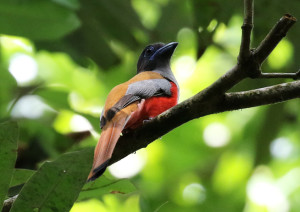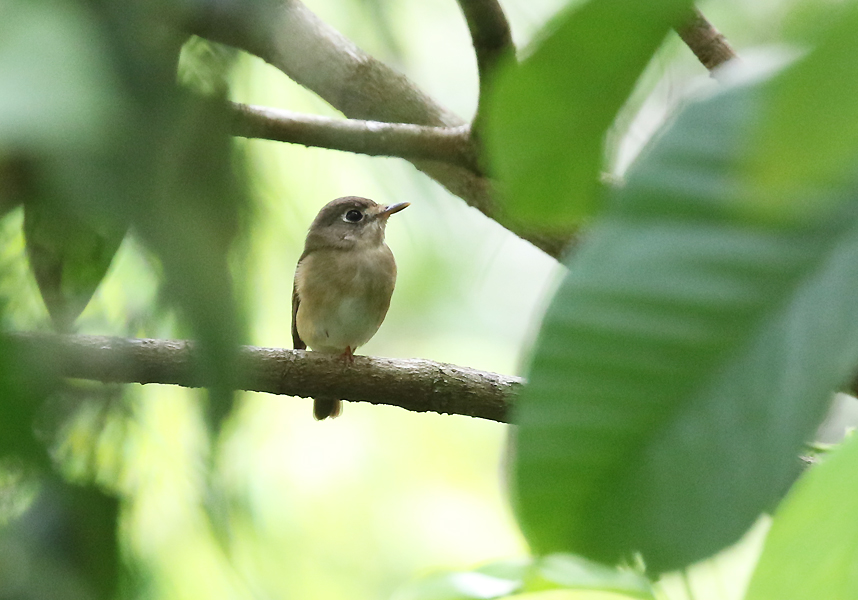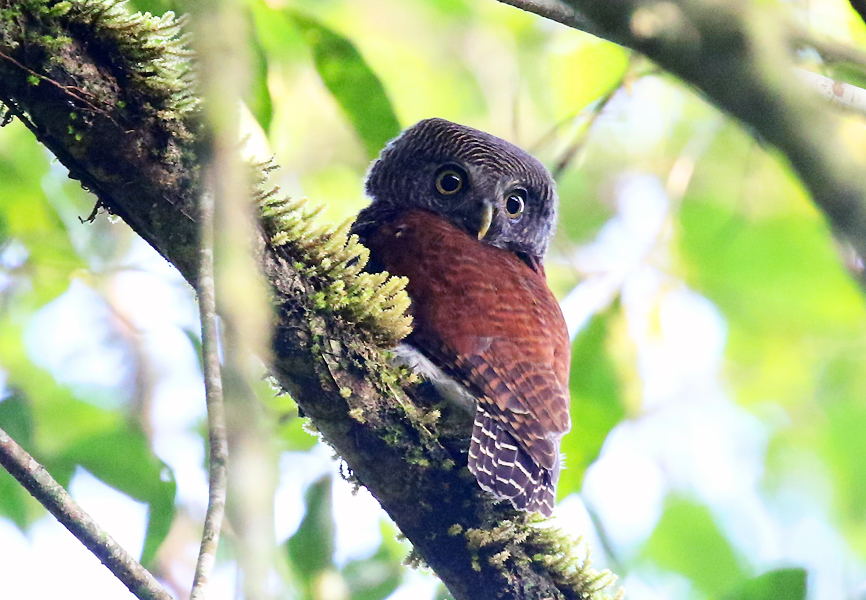
If you want superb views across a forest-lined river, steamy mist forming over the forest, a fantastic morning chorus and lots of birds then Kitulgala is the perfect place. The location that was famously used for filming of the movie “The Bridge on the River Kwai” does not disappoint visually and with three nights here it did not disappoint ornithologically either. Staying at Kitulgala Resthouse my room had a superb view across the river to the forest and village groves where most birders head but even around the guesthouse grounds birds were abundant, particularly in the early morning. Over the course of my stay birds were abundant in the orchards and gardens around the village and forest patches, making seeing a good number of Sri Lanka’s key species fairly easy, although birding the forest itself was quite difficult and slow, typical of tropical forest birding in Asia. Some of the best birds I saw at Kitulgala included Malabar Trogon, Sri Lanka Grey Hornbill, Layard’s Parakeet, Legge’s Hawk Eagle, Sri Lanka Hanging Parrot and a wonderful encounter with a pair of Sri Lanka Spurfowl.
Kitulgala will feature on all my birding tours to Sri Lanka. If you would like to join one check out the details here - Sri Lanka Birding Tour.
On arrival at Kitulgala Resthouse I was greeted by the staff, a welcome drink and a couple of Square-tailed Bulbuls chasing each other around in the garden shrubbery. This species was previously considered a subspecies of Black Bulbul but has been split; certainly the call is not the same as the Black Bulbuls I frequently see in Northern Thailand. The small area of gardens at the hotel was full of large trees and flowering shrubs that attracted birds and adjacent to other similar gardens and overlooking a river and forest on the opposite bank, so a location well-positioned to receive quite a wide variety of birds as I would find out over the course of the next few days.
Birding around the hotel gardens provided me with a lot of sightings. White-browed Fantail, Indian Robin, Common Tailorbird, Indian White-eye, Loten’s Sunbird, Black-hooded Oriole and Red-vented Bulbul were all nice but when I recognized the call of a Hanging Parrot a searched it out and quickly located a Sri Lanka Hanging Parrot perched on top of a tree. This endemic species turned out to be a common bird in this area with frequent sightings of them raiding fruit trees in gardens.
Another superb bird that was frequent around the hotel and all the village gardens was Red-backed Flameback. This is another bird that has been split, this time from Black-rumped Flameback, to be another endemic species for Sri Lanka and it was nice that such a spectacular bird was common. I really like all species of woodpecker so never became bored of this bird no matter how many times I saw it.
Dawn choruses are something that birders often talk about and at Kitulgala I experienced possibly the busiest morning chorus I have ever heard every morning of my stay there. Even before first light there was an amazing amount of bird vocalisation from diurnal birds, bulbuls, parakeets, sunbirds, barbets and woodpeckers. Looking out of my hotel room window, just as the first glow of morning light was emerging I could see that not only was their a lot of bird song but a lot of activity too, even in less than half light. In fact this amount of extremely early activity caught me a little by surprise so I went out to see what was about in something of a rush. One of the birds that caught my attention was a male Loten’s Sunbird which would feed on a flowering bush every morning. This bird with its amazing bill was an expert at getting at the nectar from flowers without exposing itself for a photograph and I only finally captured it when it sat on some wires.
Another regular visitor to the hotel garden in the very early morning was Brown-capped Pygmy Woodpecker. Before it was fully light I could hear the high-pitched trilling call coming from tall trees and although I managed to see it before it flew away to a patch of forest it was frustratingly elusive, never giving me a good view. Fortunately I caught up with a pair of these tiny woodpeckers in some trees within a small tea plantation.
Brown-breasted Flycatcher is a bird I have only seen once before, in Northern Thailand where it is a very rare breeding species, so it was nice to find this bird while walking around in a forest patch in among the village. Brown-breasted Flycatcher is not one of the most spectacular birds in Sri Lanka but I think it made for a nice photograph none the less.
The villages in the Kitulgala area have a lot of interesting gulleys full of overgrown vegetation, gardens full of fruiting trees and patches of ancient forest here and there and while I was exploring one of the wilder spots I noticed that what first seemed like yet more of the ubiquitous Yellow-billed Babblers were actually something different. A busy group of endemic Orange-billed Babblers were busy grabbing insects from the underside of leaves and feeding them to their begging young. There seemed to be several family parties all in the same area, all taking advantage of an abundance of food.
While watching these entertaining birds I heard a sweet song somewhere behind me. I was able to walk into an overgrown, abandoned garden that was almost completely reclaimed by the forest to encounter something that I had been expecting would take more effort; a Spot-winged Thrush. This bird was sitting on a perch singing away just a few metres away from me and over the course of the next hour I was able to watch it, photograph it and make this short video of it in song. A real treat.
Another of the key species at Kitulgala is Chestnut-backed Owlet. This is a bird which is active in the early morning so I was always alert, listening out for its distinctive call and when I did, I got as close to it as possible. Hearing the bird calling from a nearby tree it was not actually difficult to find due to the large number of birds mobbing it. Yellow-billed Babblers, Square-tailed Bulbuls, sunbirds, flowerpeckers and suchlike were aggressively attacking the owlet. In fact although I have seen small songbirds mobbing owlets many times before I have never seen an attack like this with birds actually smashing into the owlet and plucking feathers from it.
The abundance of birds around the village here reflects the attitude of the locals who obviously do not hunt or persecute the birds in any way. Birds such as Sri Lanka Junglefowl and Green Imperial Pigeon, which would make a good meal and would be hunted to near elimination in many countries, were numerous and easy to observe.
One of the largest species that can be found at Kitulgala is Sri Lanka Grey Hornbill and just as I was wondering where I should look for this bird one came swooping past me at eye level to land in someone’s garden. Once I had caught up with it I found it feeding on rice that had been put on a bird table with two ladies standing just a few metres away catching up on the village gossip! It is always nice to visit a place where humans and birds are able to live alongside each other.
Stretching this level of tolerance to its limit were birds feeding on fruit trees in people’s gardens. Birds such as Red-vented Bulbul and Sri Lanka Hanging Parrot were birds I commonly saw doing this but the highlight of the “scrumping species” were a small group of endemic Layard’s Parakeet. Although I saw a few more of these birds around Kitulgala by far the best and most prolonged views of this scarce endemic were as they were raiding a fruit tree close to the hotel.
Bulbuls are not usually high on most “wish-lists” but there are a few endemic members of this family to be found at Kitulgala apart from Square-tailed Bulbul. I only saw each of Yellow-browed Bulbul and Black-capped Bulbul a few times during my stay with the latter only seen in the hotel garden. However, I managed to get good views and a couple of photos of these species.
This type of birding was very pleasant and enjoyable, with excellent views of most of the birds in the area but within the forest itself there are some species that are unlikely to be seen within the gardens and orchards. A couple of well-maintained trails took me through the forest after paying the admission fee. Like many tropical forests although I could hear birds it was very tricky to actually see them. Bulbuls in the treetops were impossible to see but Lesser Yellownape Woodpecker was more obliging. Tickell’s Blue Flycatcher showed itself after some time trying to track it down from its high-pitched song and a couple of Black-naped Monarchs were easily seen. The bell-like mimicry of Sri Lanka Drongo rang through the forest as one of the most common sounds and it was certainly one of the easier forest birds to see.
Hot and humid, it was hard going birding in this forest but with persistence and several visits I got good views of Sri Lanka Scimitar Babbler, Southern Hill Myna and Oriental Dwarf Kingfisher before hearing a soft sound that I recognised as a Trogon. Malabar Trogon was high on the list of desirable birds so I scanned through the forest keenly, spotting a slash of red through the dense foliage. Moving my head slightly revealed a male Malabar Trogon; one line of sight through the forest to this gem. Hanging around in this area eventually gave me some excellent views of this stunning bird and even a photo opportunity.
On my final morning at Kitulgala I made a last visit into the forest, starting down the forest trail at first light. The level of bird activity was no greater than on any other visit but I was about to get one of the most pleasing sightings of my birding trip to Sri Lanka. Hearing a distinctive call coming from the forest floor I slowly stepped off of the trail and moved as quietly as possible towards the sound. Not wanting to get too close and disturb the origin of this call I scanned the forest floor with my binoculars and was delighted to see a pair of Sri Lanka Spurfowl duetting. I didn’t attempt to take any photographs, it was pointless through the dense forest, instead I just enjoyed the scene of the male and female Spurfowl calling back and forth.
My next birding destination in Sri Lanka was to be Nuwara Eliya but Kitulgala will be on my next visit to Sri Lanka. If you would like to join me check out the itinerary and dates here – Sri Lanka Endemcis Birding Tour.


 May 5th, 2022
May 5th, 2022  Nick
Nick 















 Posted in
Posted in  Tags:
Tags: 









